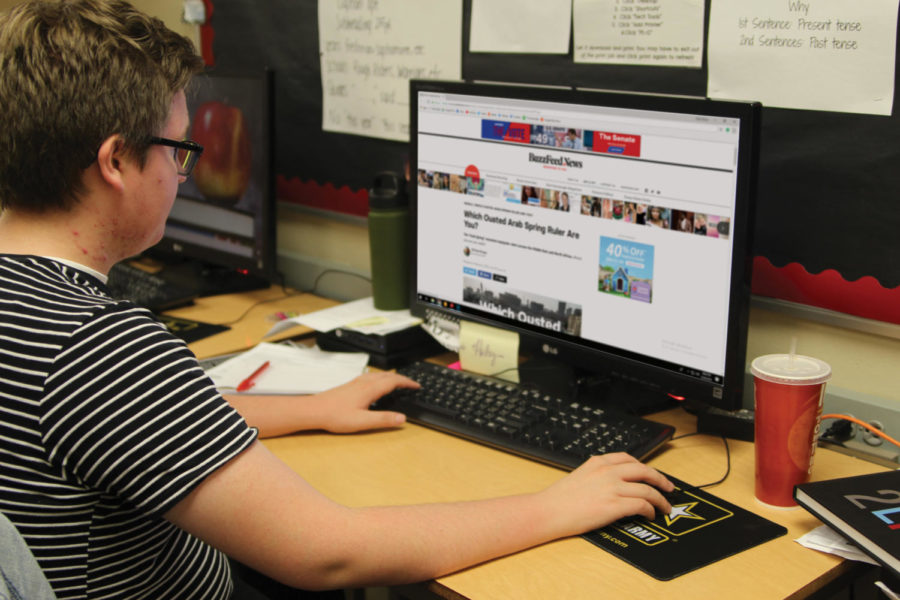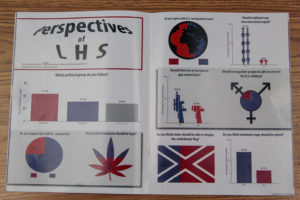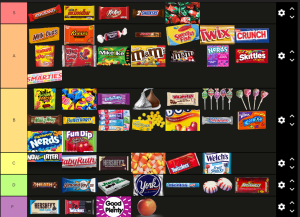No, the Statesman isn’t fake news
How Statesman editorials have earned the school newspaper a reputation for being liberal propaganda

Editor Gage Gremlick researches new story ideas for the Statesman
September 20, 2018
Some may say that the Statesman is the journalistic equivalent of the one outspoken liberal in social studies who always raises their hand in class to insert their opinion, regardless of the context.
Many students claim that our beloved school newspaper “doesn’t represent our school” or that it’s not actually news. And, considering some of the editorials that the newspaper has run in the past, one might be able to understand that perspective. From “Getting paid less for being biologically unfit” (posted online last year) to “Gun violence and gun control: when will there be a solution?” (printed in the January 2018 issue) one might conclude that the Statesman slants left.
Don’t get me wrong, I’m not trying to roast the articles written by members of the staff. There’s nothing wrong with students using the school newspaper as a platform to express their views through an editorial. But why do so many see The Statesman as liberal nonsense?
There’s a distinct difference between Statesman issues now and Statesman issues from two or three years ago. Upon perusing the archives one will discover that editorials printed in our newspaper have shifted in tone. Whereas in the past the Statesman featured more light-hearted pieces, mixed in with a few serious stories, newer issues feature editorials which tackle issues like grief, school shootings and addiction. These newer stories feature polarizing topics which are bound to evoke a strong reaction from at least a handful of readers. This problem is worsened by the fact that most students’ only interaction with the Statesman is with the paper edition, in ad-room. The problem is that the paper edition has moved away from news reporting. Instead, it has shifted towards analysis or editorials. This type of journalism is persuasive, but some students are confused because they think that editorials are supposed to serve as news when they’re actually intended to present one side of an argument.
The negative perception of the Statesman isn’t entirely due to reader confusion, though. The problem also stems from the way the print edition is laid out. Many editorials have too broad of topics for the 500 words allotted. This forces writers condense a broad issue into a concise, generalized form. Space limitations also prevent the author from adequately acknowledging the other side which results in a reader feeling alienated by a` writer if they don’t agree with them. There are two solutions to this conundrum: either writers need more focused topics, or they need more space to unpack a problem. Editorials in the publication often bite off more than they can chew inside of their word limit. The end result is an article with an interesting headline, but a story that feels like it should be twice as long.
Although there are a handful of op/eds which support conservative views, it wouldn’t be overstepping to say that many editorials about controversial topics printed in the paper lean to the left. This shouldn’t be the case according to a general poll taken of the Statesman staff which found that the staff is pretty well balanced in terms of political views (although only 16 members responded). Ideas about why op-eds lean left are mostly speculation. It’s possible that in the past there have been one or two passionate students who wanted to share liberal views, and that’s fine. Students with conservative views may just not feel the need to share their views.

To be fair, there have been times when the Statesman hasn’t handled political topics very delicately. One feature that readers might have found particularly memorable is “Perspectives of LHS”, which ran in November of last year. This infographic shows the results of a poll which asked Lincoln students about their perspectives on a variety of issues, almost all of which were social. The poll gave students generalized questions like “Do you support the LGBTQ+ community” and “Should employers pay women and men equal”. The design was problematic, and as a student who wasn’t on staff at that time, I remember being upset with the way the results were presented and how the questions were asked. However, this was one story which had a few problems. The problems weren’t necessarily deliberate, there were just a few mistakes. And, as a student-led newspaper, the Statesman makes plenty of mistakes. There are some things the newspaper could change in order to balance its writing.
The school newspaper should represent the student body, but the student body doesn’t have just one voice. It would be beneficial for everyone if there were more perspectives presented in The Statesman. No class is fun when it’s just one person giving their opinion with no actual conversation, and we can all agree that that’s not what we want the paper to be.
If you have an idea for an editorial or you want to write a letter to the editors, contact the Statesman staff.








